Effects of Hybridized Synthetic Fibers on the Shear Properties of Cement Composites
Abstract
1. Introduction
2. Hybridization of Synthetic Fibers
- Fiber size. In this study, two different fiber classes were hybridized to produce macro–micro-fiber-mix combinations. Each fiber class is subjected to bridge the different levels of cracks during shear failure. The influence of other parameters may affect the conventional fiber-bridging capabilities of the macro–micro combination, which were further investigated.
- Fiber length. Fiber length corresponds to effective fiber-bridging capabilities. Shorter fibers lead to higher fiber count per density, resulting in enhanced concrete performance through multi-cracking. Longer fibers tend to improve the post-cracking behavior by enabling a quasi-brittle mode of failure. The effects of different fiber lengths from different types of fibers used were then further studied.
- Volume fraction of fibers. The different volume fractions of fibers were used to evaluate the possible variations in shear strength for the macro–micro-fiber combinations with increasing fiber dosage, as well as to determine an optimal macro–micro-fiber combination.
- Bonding power. The intensity of bond stress between the fibers and their surrounding cementitious matrix determines the fiber failure, whether by fiber-breakage or effective pull-out failure. The mode of failure influences the overall shear strength and toughness of HyFRC.
- Manufactured materials. The materials considered in this study were polypropylene and polyethylene for the primary fibers and polypropylene and nylon for the secondary microfibers. Additives were added to differentiate the fibers from other synthetic fibers. Each material has varying tensile strength, which is directly correlated with the fiber mode of failure.
- Fiber form. The manufactured form has a direct relationship with the bonding power, which provides different anchorage intensities during fiber-bridging. The anchorage intensity for each fiber in improving the shear strength of HyFRC was assessed.
3. Results and Discussion
3.1. Density
3.2. Shear Strength
3.3. Shear Energy
4. Assessment of Results
Hybridization Synergy
5. Conclusions
Author Contributions
Funding
Acknowledgments
Conflicts of Interest
References
- Zollo, R.F. Fiber-reinforced concrete: An overview after 30 years of development. Cem. Concr. Compos. 1997, 19, 107–122. [Google Scholar] [CrossRef]
- ACI Committee 544. State-of-the-Art Report on Fiber Reinforced Concrete; American Concrete Institute: Farmington Hills, MI, USA, 2002. [Google Scholar]
- McCraven, S.C. Fibers for Tomorrow. In Concrete Construction; Hanley Wood LLC: Washington, DC, USA, 2002; pp. 27–30. [Google Scholar]
- Swolfs, Y.; Gorbatikh, L.; Verpoest, I. Fibre hybridisation in polymer composites: A review. Compos. Part A Appl. Sci. Manuf. 2014, 67, 181–200. [Google Scholar] [CrossRef]
- Walton, P.L.; Majumdar, A.J. Cement Based Composites with Mixtures of Different Types of Fibres. Composites 1975, 6, 209–216. [Google Scholar] [CrossRef]
- Banthia, N.; Sheng, J. Micro-reinforced Cementitious Materials. MRS Proc. 1991, 211, 25–32. [Google Scholar] [CrossRef]
- Soroushian, P.; Mirza, F.; Alhozajiny, A. Plastic Shrinkage Cracking of Polypropylene Fiber Reinforced Concrete. ACI Mater. J. 1993, 92, 553–560. [Google Scholar]
- Banthia, N.; Soleimani, S.M. Flexural response of hybrid fiber-reinforced cementitious composites. ACI Mater. J. 2005, 102, 382–389. [Google Scholar]
- Kotecha, P.; Abolmaali, A. Macro synthetic fibers as reinforcement for deep beams with discontinuity regions: Experimental investigation. Eng. Struct. 2019, 200, 109672. [Google Scholar] [CrossRef]
- Babafemi, A.J.; Boshoff, W.P. Pull-out response of macro synthetic fibre from concrete matrix: Effect of loading rate and embedment length. Constr. Build. Mater. 2017, 135, 590–599. [Google Scholar] [CrossRef]
- Parra-Montesinos, G.J.; Peterfreund, S.W.; Chao, S.H. Highly damage-tolerant beam-column joints through use of high-performance fiber-reinforced cement composites. ACI Struct. J. 2005, 102, 487–495. [Google Scholar]
- Roesler, J.R.; Altoubat, S.A.; Lange, D.A.; Rieder, K.A.; Ulreich, G.R. Effect of synthetic fibers on structural behavior of concrete slabs-on-ground. ACI Mater. J. 2006, 103, 3–10. [Google Scholar]
- Xu, L.; Huang, L.; Chi, Y.; Mei, G. Tensile behavior of steel-polypropylene hybrid fiber-reinforced concrete. ACI Mater. J. 2016, 113, 219–229. [Google Scholar] [CrossRef]
- Altoubat, S.; Yazdanbakhsh, A.; Rieder, K.A. Shear behavior of macro-synthetic fiber-reinforced concrete beams without stirrups. ACI Mater. J. 2009, 106, 381–389. [Google Scholar]
- Ramanalingam, N.; Paramasivam, P.; Mansur, M.A.; Maalej, M. Flexural Behaviour of Hybrid Fiber-Reinforced Cement Composites Containing High-Volume Fly Ash. ACI SP 2001, 199, 147–162. [Google Scholar]
- Navas, F.O.; Navarro-Gregori, J.; Herdocia, G.L.; Serna, P.; Cuenca, E. An experimental study on the shear behaviour of reinforced concrete beams with macro-synthetic fibres. Constr. Build. Mater. 2018, 169, 888–899. [Google Scholar] [CrossRef]
- Banthia, N.; Gupta, R. Hybrid Fiber Reinforced Concrete: Fiber Synergy in High Strength Matrices. RILEM Mater. Struct. 2004, 37, 707–716. [Google Scholar] [CrossRef]
- Greenough, T.; Nehdi, M. Shear Behaviour of Self-Consolidating Fibre-Reinfored Concrete Slender Beams. ACI Mater. J. 2008, 105, 468–477. [Google Scholar]
- Sun, W.; Chen, H.; Luo, X.; Qian, H. The effect of hybrid fibers and expansive agent on the shrinkage and permeability of high performance concrete. Cem. Concr. Res. 2001, 31, 595–601. [Google Scholar] [CrossRef]
- Ma, K.; Qi, T.; Liu, H.; Wang, H. Shear behavior of hybrid fiber reinforced concrete deep beams. Materials 2018, 11, 2023. [Google Scholar] [CrossRef] [PubMed]
- Jongvivatsakul, P.; Matsumoto, K.; Niwa, J. Shear Capacity of Fiber Reinforced Concrete Beams With Various Types and Combinations of Fibers. J. JSCE 2013, 1, 228–241. [Google Scholar] [CrossRef]
- Zhang, R.; Matsumoto, K.; Hirata, T.; Ishizeki, Y.; Niwa, J. Shear Behavior of Polypropylene Fiber Reinforced Ecc Beams With Varying Shear Reinforcement Ratios. J. JSCE 2014, 2, 39–53. [Google Scholar] [CrossRef]
- Joshi, S.S.; Thammishetti, N.; Prakash, S.S. Efficiency of steel and macro-synthetic structural fibers on the flexure-shear behaviour of prestressed concrete beams. Eng. Struct. 2018, 171, 47–55. [Google Scholar] [CrossRef]
- Yew, M.K.; Mahmud, H.B.; Shafigh, P.; Ang, B.C.; Yew, M.C. Effects of polypropylene twisted bundle fibers on the mechanical properties of high-strength oil palm shell lightweight concrete. Mater. Struct. Constr. 2016, 49, 1221–1233. [Google Scholar] [CrossRef]
- Zainal, S.M.I.S.; Hejazi, F.; Aziz, F.N.A.A.; Jaafar, M.S. Constitutive Modeling of New Synthetic Hybrid Fibers Reinforced Concrete from Experimental Testing in Uniaxial Compression and Tension. Crystals 2020, 10, 885. [Google Scholar] [CrossRef]
- Yin, S.; Tuladhar, R.; Collister, T.; Combe, M.; Sivakugan, N. Mechanical Properties and Post-crack Behaviours of Recycled PP Fibre Reinforced Concrete. In Proceedings of the 27th Biennial National Conference of the Concrete Institute of Australia, Melbourne, VIC, Australia, 30 August—2 September 2015; pp. 414–421. [Google Scholar]
- Shen, L.; Worrell, E.; Patel, M.K. Open-loop recycling: A LCA case study of PET bottle-to-fibre recycling. Resour. Conserv. Recycl. 2010, 55, 34–52. [Google Scholar] [CrossRef]
- Strezov, L.; Herbertson, J. A Life Cycle Perspective on Steel Building Materials; Crucible Group Pty Ltd.: Townsville, Australia, 2006. [Google Scholar]
- Akkaya, Y.; Peled, A.; Shah, S.P. Parameters related to fiber length and processing in cementitious composites. Mater. Struct. 2006, 33, 515–524. [Google Scholar] [CrossRef]
- JSCE-G-533. Test method for shear strength of steel fiber reinforced concrete. In Standard Specifications for Concrete Structures, Test Methods and Specifications; JSCE: Tokyo, Japan, 2005; p. 362. [Google Scholar]
- Mirsayah, A.A.; Banthia, N. Shear strength of steel fiber-reinforced Concrete. ACI Mater. J. 2002, 99, 473–479. [Google Scholar]
- Charron, J.P.; Desmettre, C.; Androuët, C. Flexural and shear behaviors of steel and synthetic fiber reinforced concretes under quasi-static and pseudo-dynamic loadings. Constr. Build. Mater. 2020, 238, 117659. [Google Scholar] [CrossRef]
- Betterman, L.R.; Ouyang, C.; Shah, S.P. Fiber-matrix interaction in microfiber-reinforced mortar. Adv. Cem. Based Mater. 1995, 2, 53–61. [Google Scholar] [CrossRef]
- Soufeiani, L.; Raman, S.N.; Jumaat, M.Z.B.; Alengaram, U.J.; Ghadyani, G.; Mendis, P. Influences of the volume fraction and shape of steel fibers on fiber-reinforced concrete subjected to dynamic loading—A review. Eng. Struct. 2016, 124, 405–417. [Google Scholar] [CrossRef]
- Brandt, A.M. Fibre reinforced cement-based (FRC) composites after over 40 years of development in building and civil engineering. Compos. Struct. 2008, 86, 3–9. [Google Scholar] [CrossRef]
- Gao, D.; Yan, Y.; Pang, Y.; Tang, J.; Yang, L.; Gu, Z. Effects of Groove and Steel Fiber on Shear Properties of Concrete with Recycled Coarse Aggregate. Materials 2020, 13, 4537. [Google Scholar] [CrossRef] [PubMed]
- Singh, S.; Shukla, A.; Brown, R. Pullout behavior of polypropylene fibers from cementitious matrix. Cem. Concr. Res. 2004, 34, 1919–1925. [Google Scholar] [CrossRef]
- Song, P.S.; Hwang, S.; Sheu, B.C. Strength properties of nylon- and polypropylene-fiber-reinforced concretes. Cem. Concr. Res. 2005, 35, 1546–1550. [Google Scholar] [CrossRef]
- Lawler, J.; Zampini, D.; Shah, S. Microfiber and Macrofiber Hybrid Fiber-Reinforced Concrete. J. Mater. Civ. Eng. 2005, 17, 595–604. [Google Scholar] [CrossRef]
- Chasioti, S.G.; Vecchio, F.J. Effect of fiber hybridization on basic mechanical properties of concrete. ACI Struct. J. 2017, 114, 375–384. [Google Scholar] [CrossRef]
- Bentur, A.; Akers, S. The microstructures and ageing of cellulose fiber reinforced cement composites cured in a normal environment. Int. J. Cem. Compos. Light. Concr. 1989, 11, 99–109. [Google Scholar] [CrossRef]
- Saghafi, M.h.; Shariatmadar, H. Enhancement of seismic performance of beam-column joint connections using high performance fiber reinforced cementitious composites. Constr. Build. Mater. 2018, 180, 665–680. [Google Scholar] [CrossRef]
- Kheni, D.; Scott, R.H.; Deb, S.K.; Dutta, A. Ductility enhancement in beam-column connections using hybrid fiber-reinforced concrete. ACI Struct. J. 2015, 112, 167–178. [Google Scholar] [CrossRef]
- Okoli, O. The effects of strain rate and failure modes on the failure energy of fibre reinforced composites. Compos. Struct. 2001, 54, 1–5. [Google Scholar] [CrossRef]
- Bolander, J.E.; Choi, S.; Duddukuri, S.R. Fracture of fiber-reinforced cement composites: Effects of fiber dispersion. Int. J. Fract. 2008, 154, 73–86. [Google Scholar] [CrossRef]
- Spadea, S.; Farina, I.; Berardi, V.P.; Dentale, F.; Fraternali, F. Energy dissipation capacity of concretes reinforced with recycled PET fibers. Ing. Sismica 2014, 31, 61–70. [Google Scholar]
- Kim, M.J.; Kim, S.; Yoo, D.Y.; Shin, H.O. Enhancing mechanical properties of asphalt concrete using synthetic fibers. Constr. Build. Mater. 2018, 178, 233–243. [Google Scholar] [CrossRef]
- Banthia, N.; Majdzadeh, F.; Wu, J.; Bindiganavile, V. Fiber synergy in Hybrid Fiber Reinforced Concrete (HyFRC) in flexure and direct shear. Cem. Concr. Compos. 2014, 48, 91–97. [Google Scholar] [CrossRef]
- Rossi, P. Ultra-high-performance fiber reinforced concretes. Concr. Int. 2001, 23, 46–52. [Google Scholar]

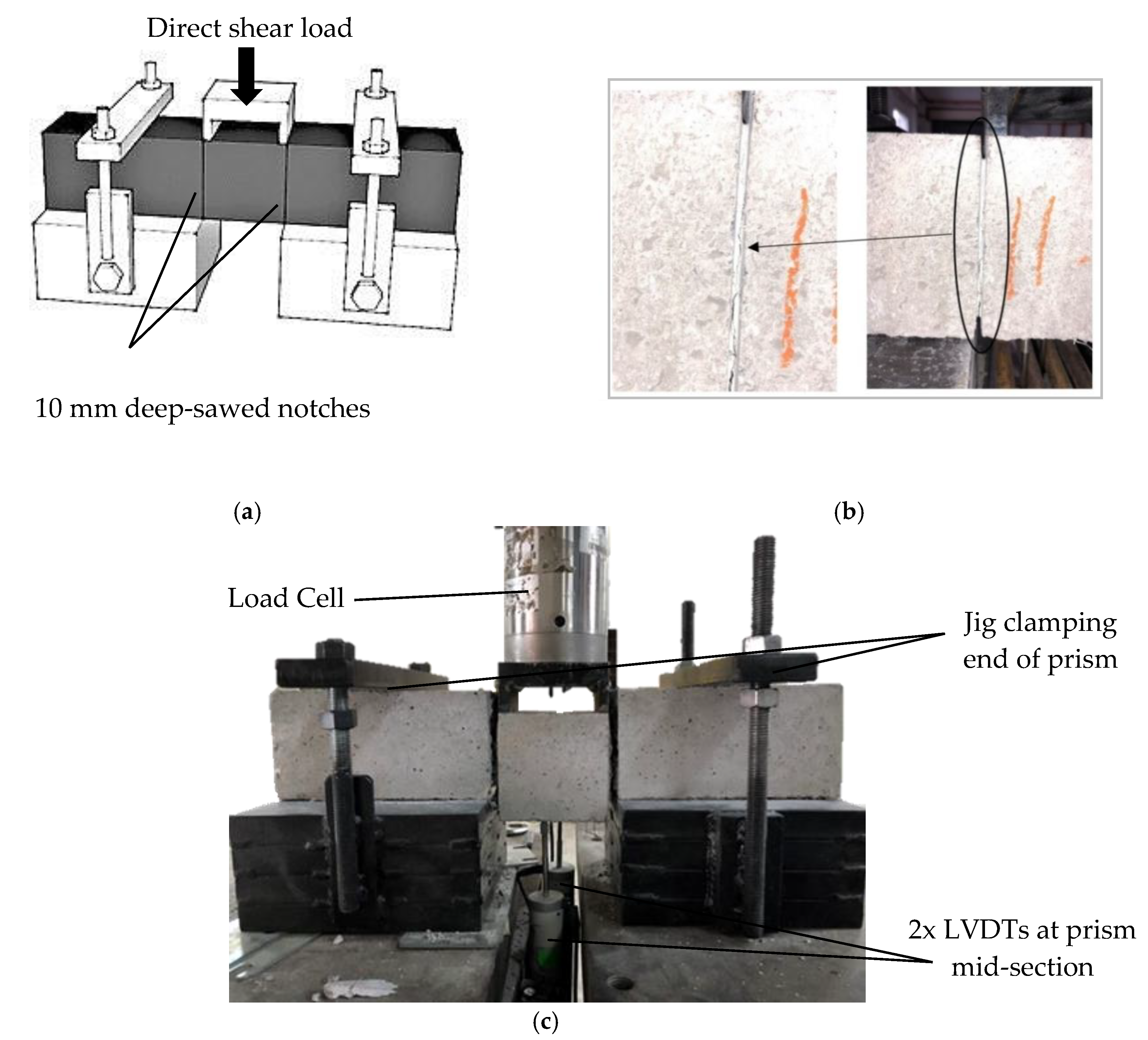
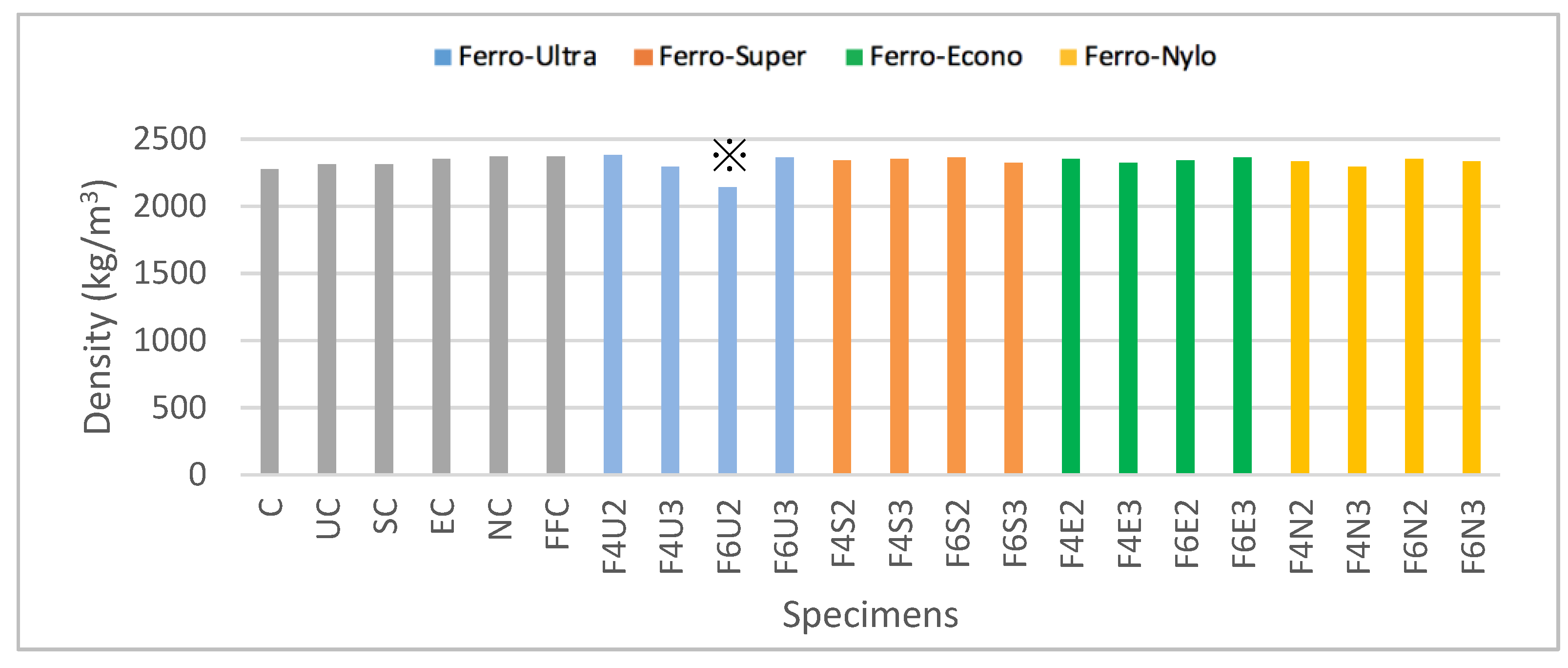
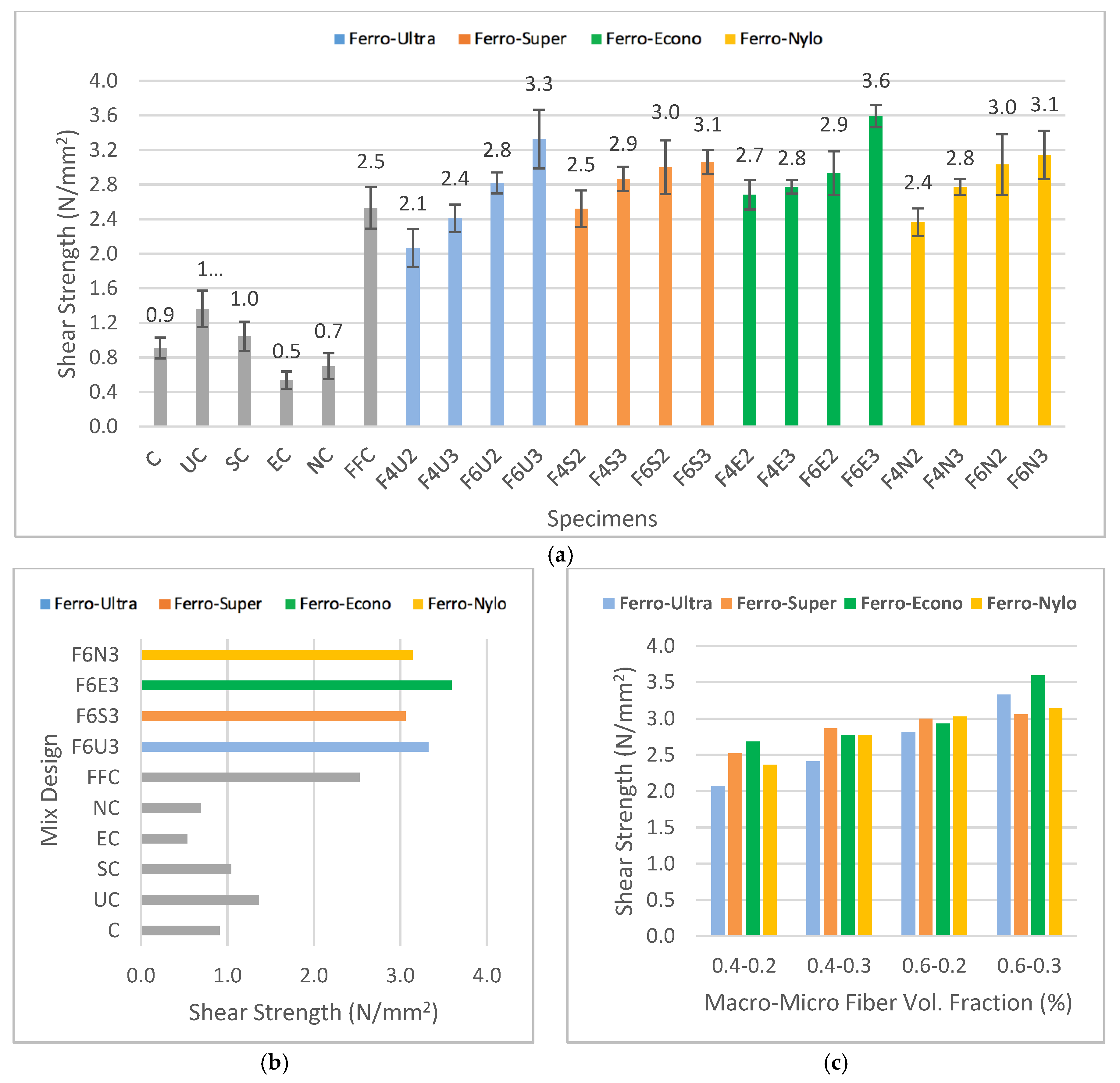
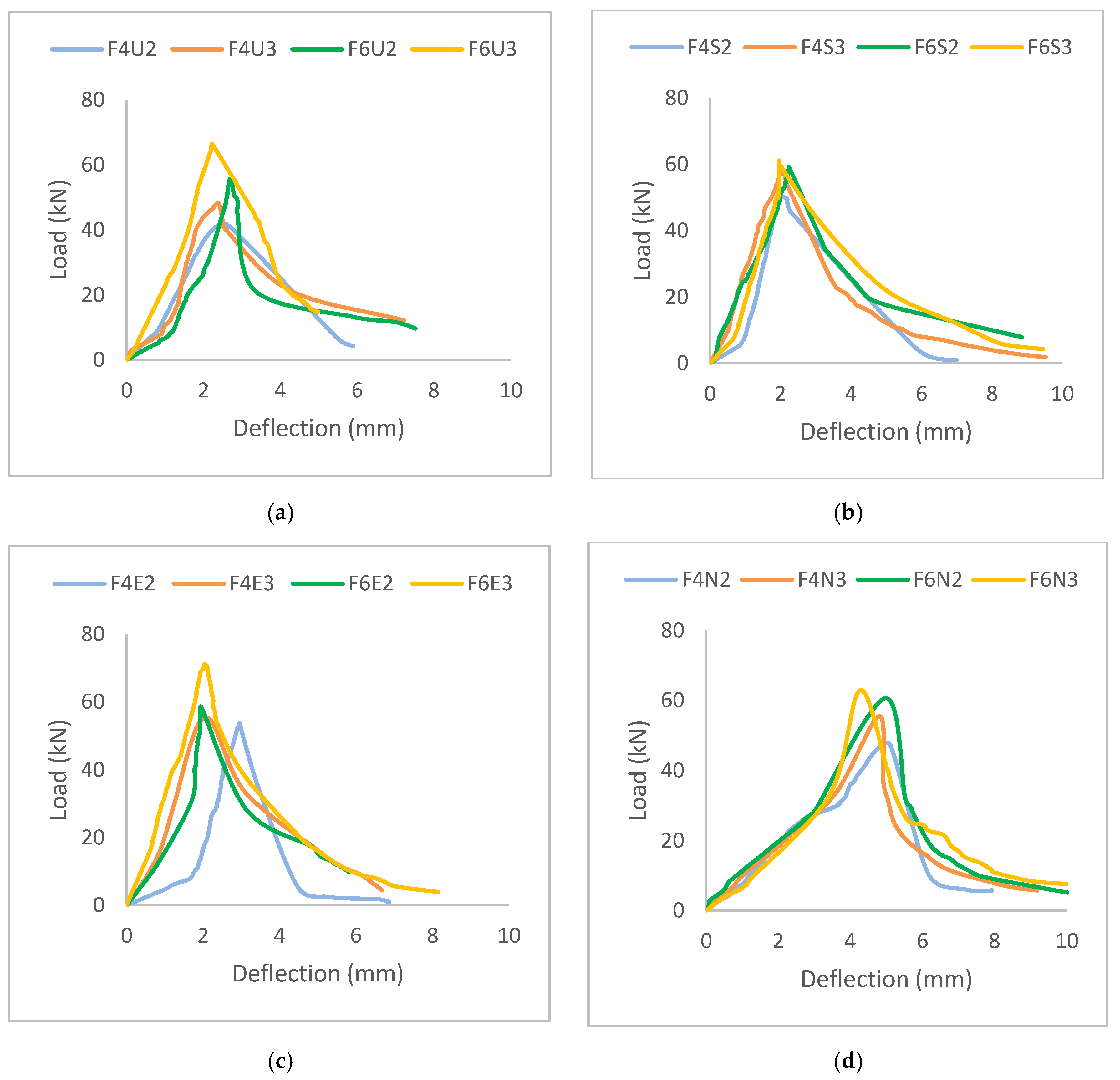
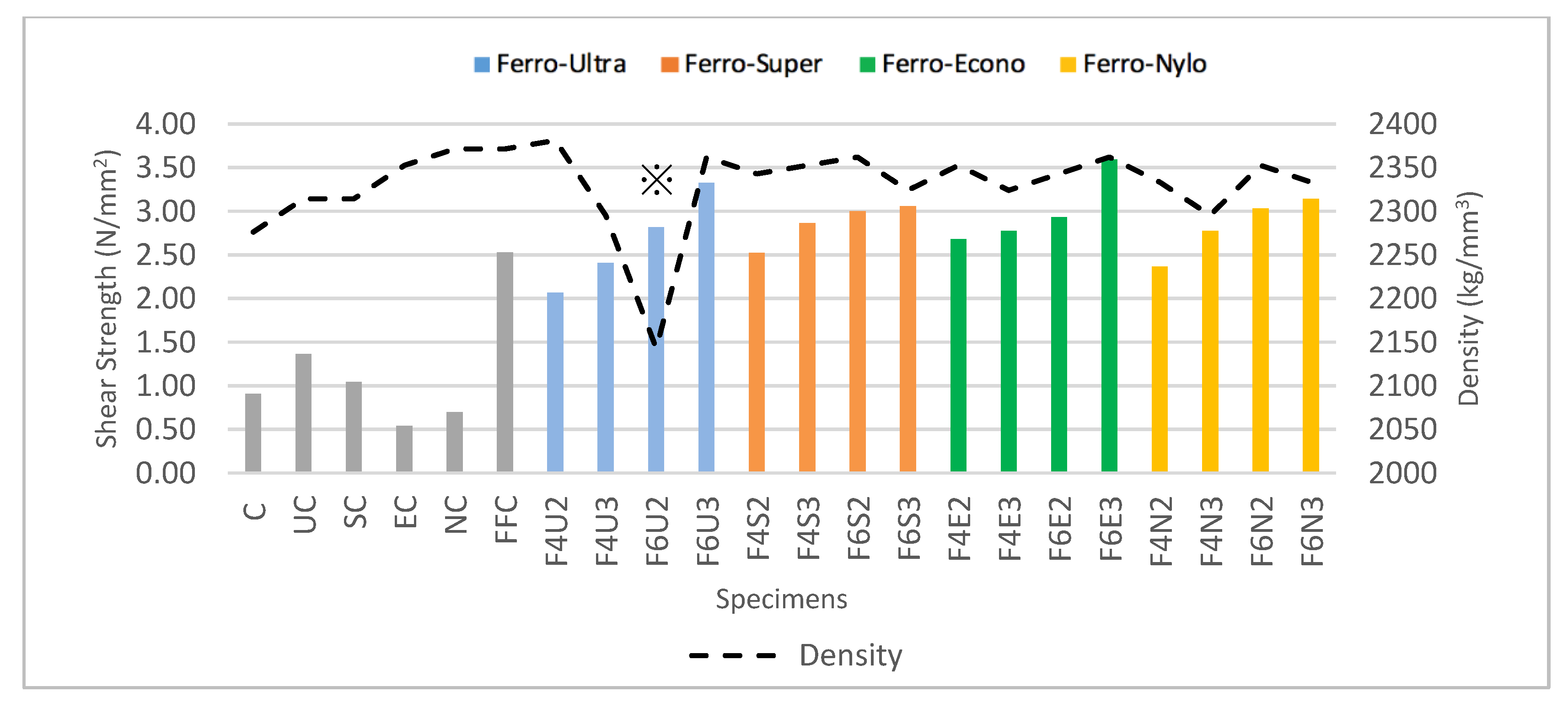
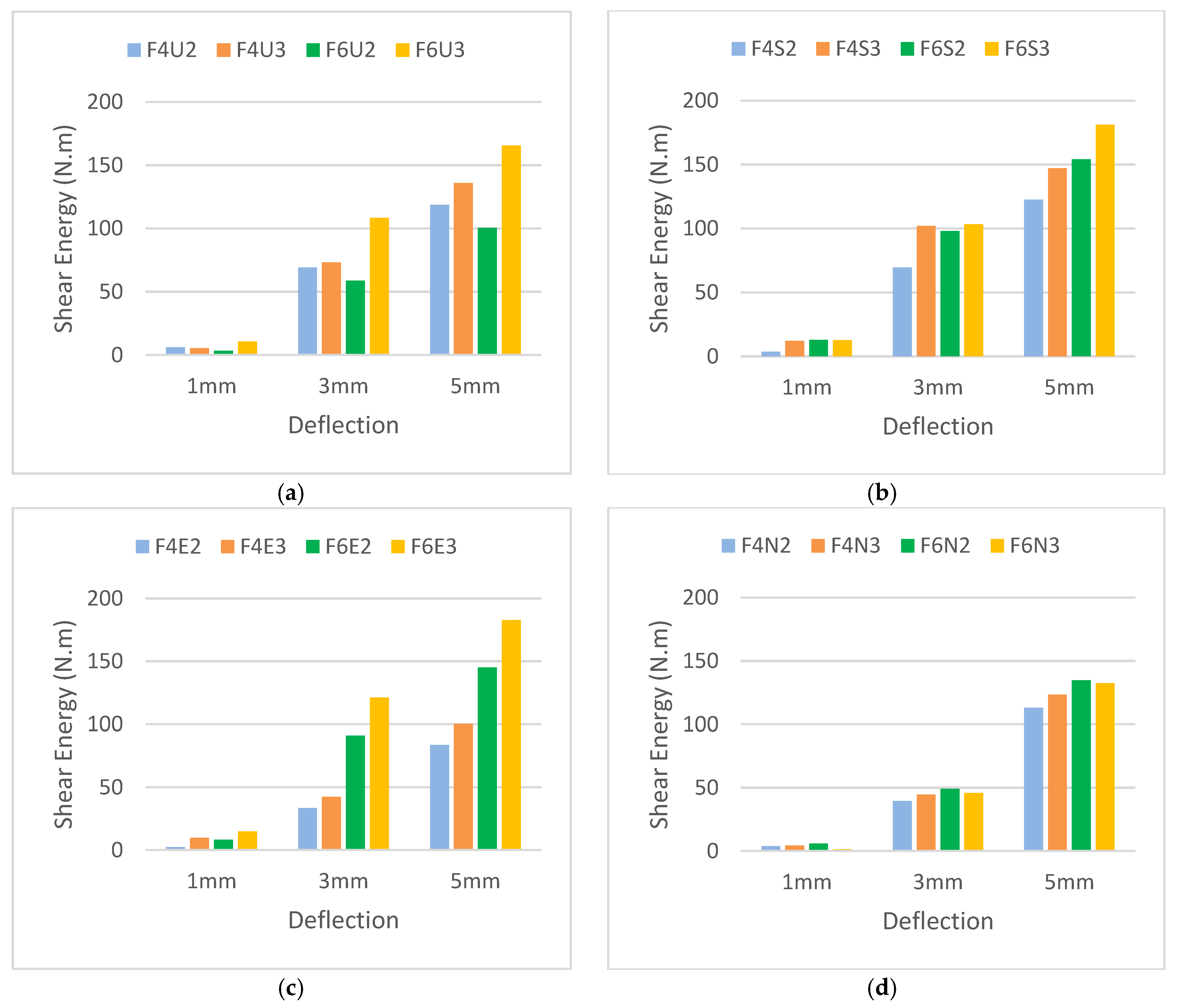
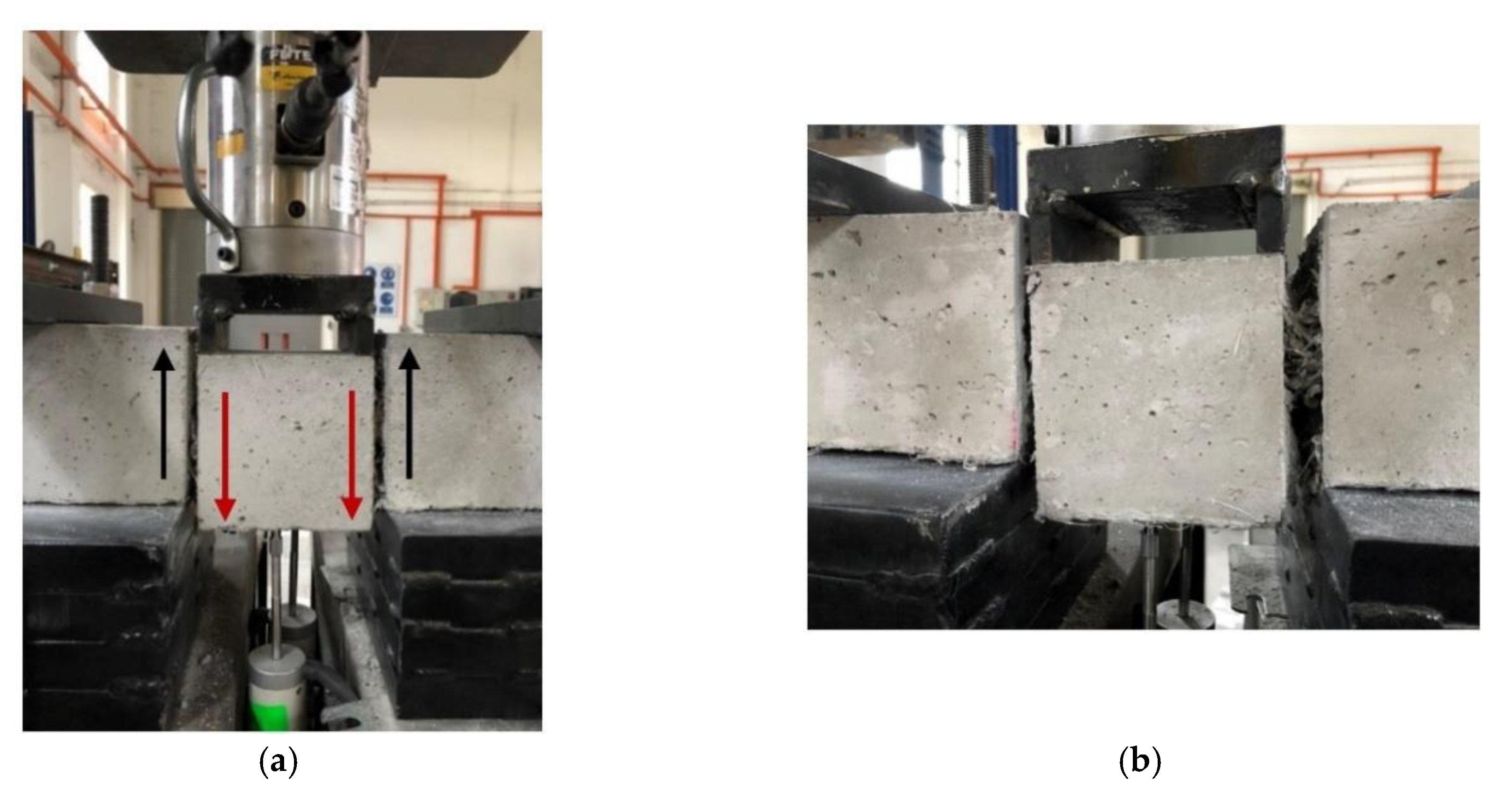
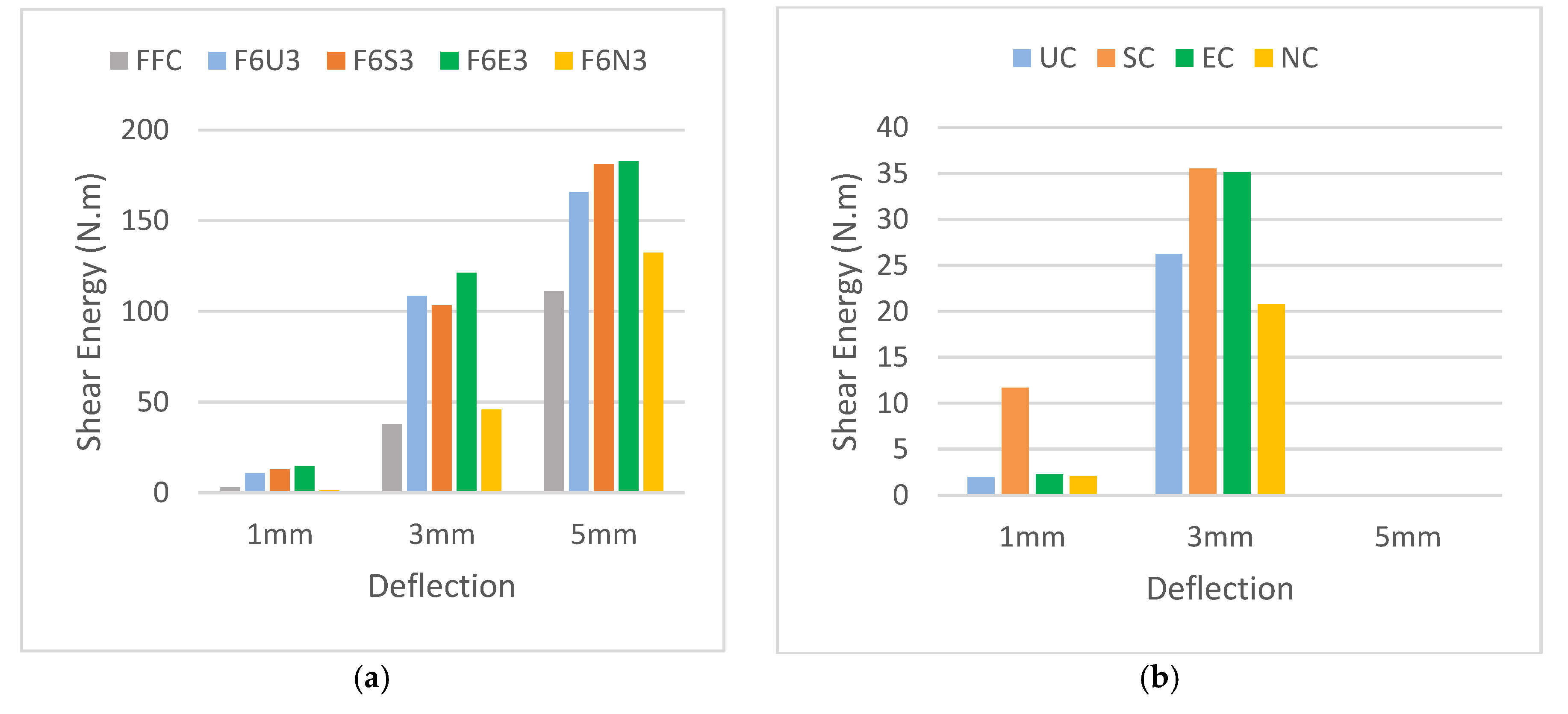
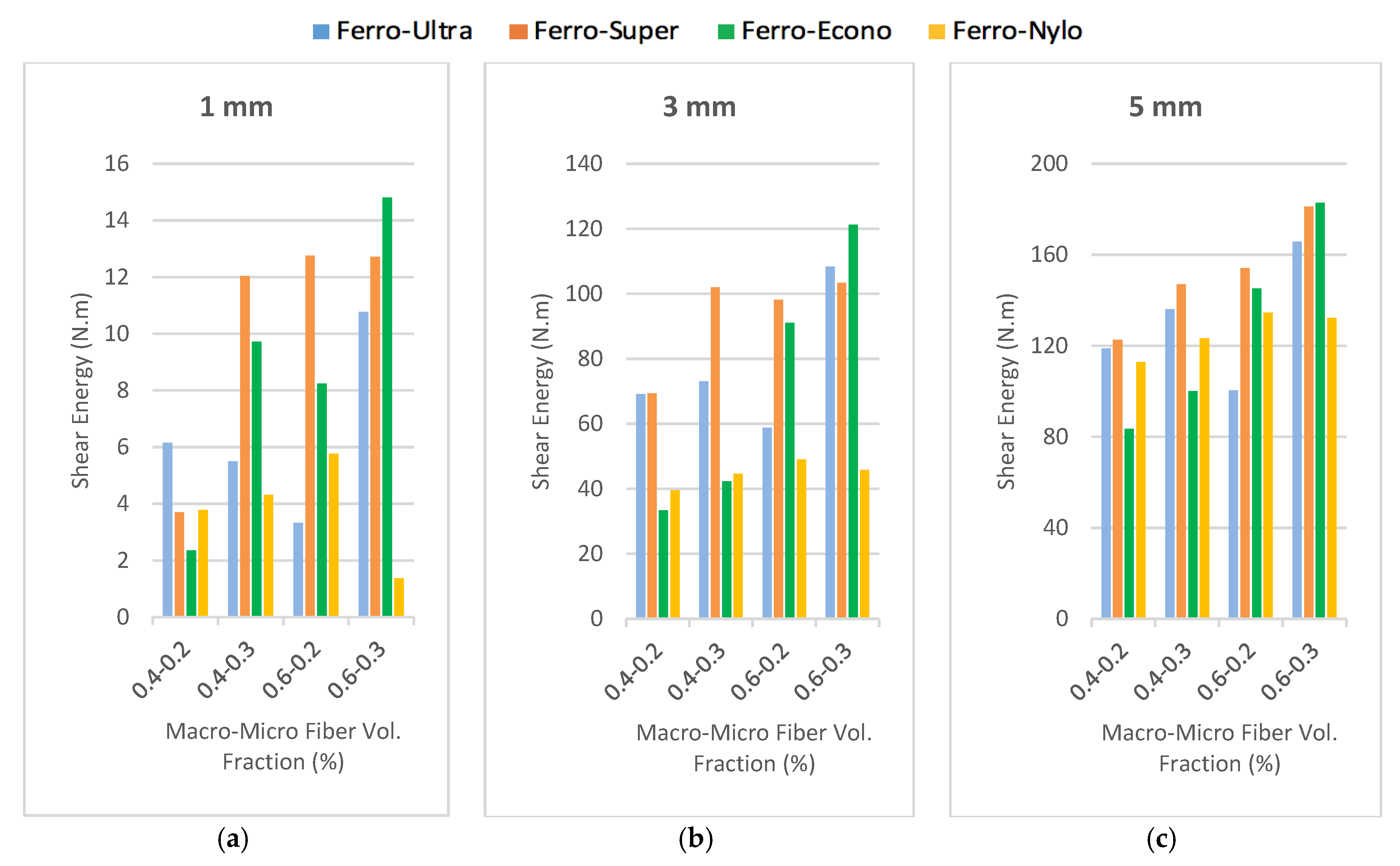

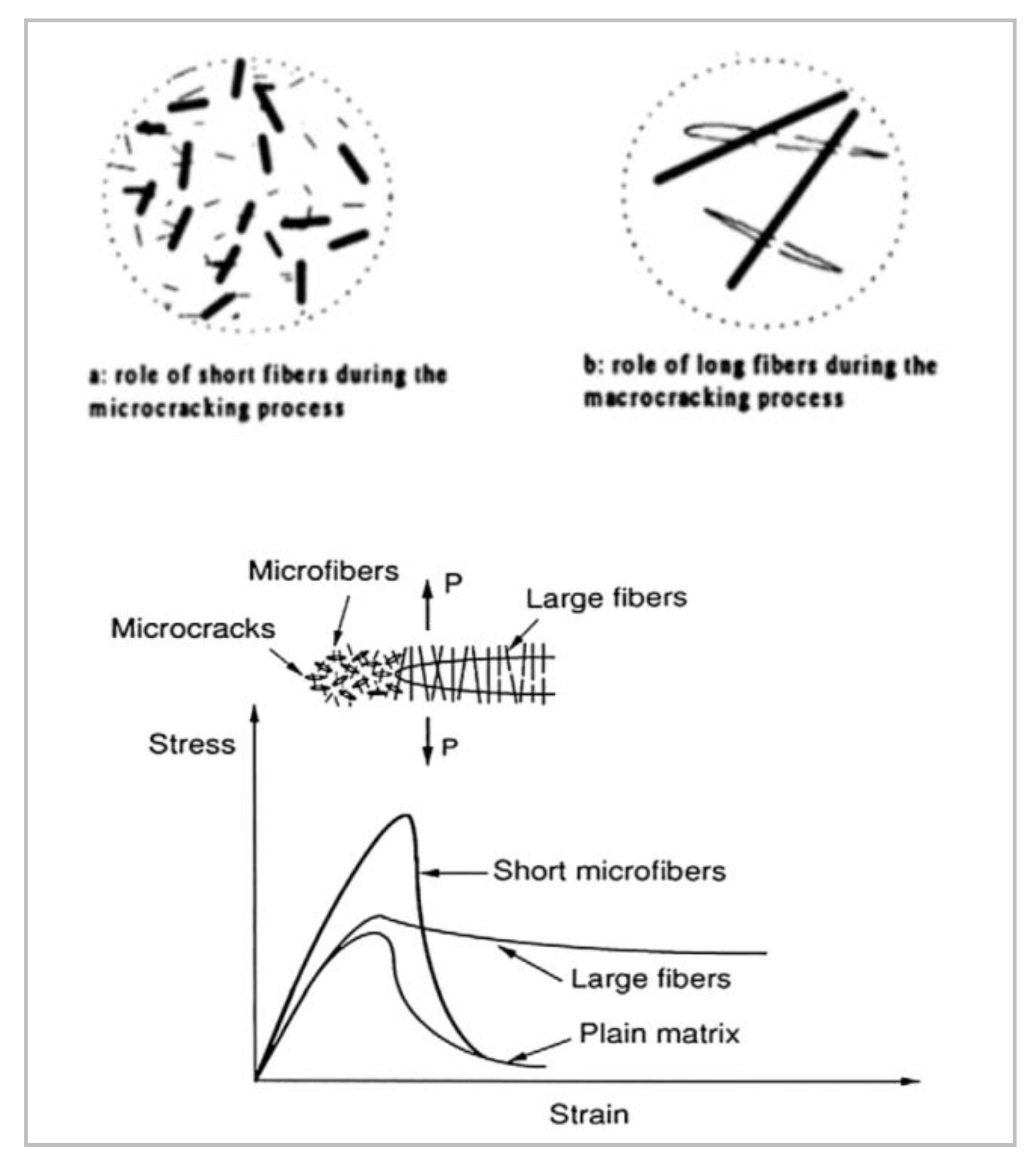
| Type | Length (mm) | Form | Bonding Power | Class | Material | Tensile Strength (MPa) |
|---|---|---|---|---|---|---|
| UC | 54 | Fibrillated Twisted Bundle | Extra heavy-duty | Micro | Polypropyleneand Additives | 570–660 |
| SC | 38 | Fibrillated | Heavy-duty | 570–660 | ||
| EC | 38 | Fibrillated | Medium-duty | 570–660 | ||
| NC | 19 | Monofilament | Light-duty | Virgin Nylon | 966 | |
| FFC1 | 38 | Fibrillated Twisted Bundle | Heavy-duty | Macro | Polyethylene, Polypropyleneand Additives | 1100 |
| FFC2 | 54 | Heavy-duty | 570–660 |
| Specimens | Designation | Type of Fibers (Vol. of Fraction, %) | Total Vol. Fraction, % | |||||
|---|---|---|---|---|---|---|---|---|
| Macrofibers | Microfibers | |||||||
| FF1 | FF2 | UN | SN | EN | NM | |||
| Control | C (Plain) | - | - | - | - | - | - | - |
| Control | UC | - | - | 0.30 | - | - | - | 0.30 |
| Control | SC | - | - | - | 0.30 | - | - | 0.30 |
| Control | EC | - | - | - | - | 0.30 | - | 0.30 |
| Control | NC | - | - | - | - | - | 0.30 | 0.30 |
| Control | FFC | 0.6 | 0.6 | - | - | - | - | 1.20 |
| 1 | F4U2 | 0.4 | 0.4 | 0.20 | - | - | - | 1.00 |
| 2 | F4U3 | 0.4 | 0.4 | 0.30 | - | - | - | 1.10 |
| 3 | F6U2 | 0.6 | 0.6 | 0.20 | - | - | - | 1.40 |
| 4 | F6U3 | 0.6 | 0.6 | 0.30 | - | - | - | 1.50 |
| 5 | F4S2 | 0.4 | 0.4 | - | 0.20 | - | - | 1.00 |
| 6 | F4S3 | 0.4 | 0.4 | - | 0.30 | - | - | 1.10 |
| 7 | F6S2 | 0.6 | 0.6 | - | 0.20 | - | - | 1.40 |
| 8 | F6S3 | 0.6 | 0.6 | - | 0.30 | - | - | 1.50 |
| 9 | F4E2 | 0.4 | 0.4 | - | - | 0.20 | - | 1.00 |
| 10 | F4E3 | 0.4 | 0.4 | - | - | 0.30 | - | 1.10 |
| 11 | F6E2 | 0.6 | 0.6 | - | - | 0.20 | - | 1.40 |
| 12 | F6E3 | 0.6 | 0.6 | - | - | 0.30 | - | 1.50 |
| 13 | F4N2 | 0.4 | 0.4 | - | - | - | 0.20 | 1.00 |
| 14 | F4N3 | 0.4 | 0.4 | - | - | - | 0.30 | 1.10 |
| 15 | F6N2 | 0.6 | 0.6 | - | - | - | 0.20 | 1.40 |
| 16 | F6N3 | 0.6 | 0.6 | - | - | - | 0.30 | 1.50 |
Publisher’s Note: MDPI stays neutral with regard to jurisdictional claims in published maps and institutional affiliations. |
© 2020 by the authors. Licensee MDPI, Basel, Switzerland. This article is an open access article distributed under the terms and conditions of the Creative Commons Attribution (CC BY) license (http://creativecommons.org/licenses/by/4.0/).
Share and Cite
Zainal, S.M.I.S.; Hejazi, F.; Aziz, F.N.A.A.; Jaafar, M.S. Effects of Hybridized Synthetic Fibers on the Shear Properties of Cement Composites. Materials 2020, 13, 5055. https://doi.org/10.3390/ma13225055
Zainal SMIS, Hejazi F, Aziz FNAA, Jaafar MS. Effects of Hybridized Synthetic Fibers on the Shear Properties of Cement Composites. Materials. 2020; 13(22):5055. https://doi.org/10.3390/ma13225055
Chicago/Turabian StyleZainal, S.M. Iqbal S., Farzad Hejazi, Farah N. A. Abd. Aziz, and Mohd Saleh Jaafar. 2020. "Effects of Hybridized Synthetic Fibers on the Shear Properties of Cement Composites" Materials 13, no. 22: 5055. https://doi.org/10.3390/ma13225055
APA StyleZainal, S. M. I. S., Hejazi, F., Aziz, F. N. A. A., & Jaafar, M. S. (2020). Effects of Hybridized Synthetic Fibers on the Shear Properties of Cement Composites. Materials, 13(22), 5055. https://doi.org/10.3390/ma13225055






